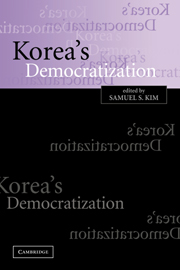Book contents
- Frontmatter
- Contents
- Tables and Figures
- Contributors
- Preface
- Part I A Framework of Analysis
- Part II Consolidation at the Mass Level
- Part III Consolidation at the Civil Society Level
- Part IV Consolidation at the State Level
- 6 Regional Politics and Democratic Consolidation in Korea
- 7 Crafting and Consolidating Constitutional Democracy in Korea
- 8 Security and Democracy in South Korean Development
- 9 The Developmental State and Democratic Consolidation in South Korea
- Bibliography
- Index
7 - Crafting and Consolidating Constitutional Democracy in Korea
Published online by Cambridge University Press: 29 July 2009
- Frontmatter
- Contents
- Tables and Figures
- Contributors
- Preface
- Part I A Framework of Analysis
- Part II Consolidation at the Mass Level
- Part III Consolidation at the Civil Society Level
- Part IV Consolidation at the State Level
- 6 Regional Politics and Democratic Consolidation in Korea
- 7 Crafting and Consolidating Constitutional Democracy in Korea
- 8 Security and Democracy in South Korean Development
- 9 The Developmental State and Democratic Consolidation in South Korea
- Bibliography
- Index
Summary
Introduction
Korea's road to democracy has been a rocky one and fraught with a seemingly endless succession of trial and error. Although a formal Westernized form of government began with liberation from thirty-five years of Japanese colonial rule in 1945, it was not until three years later, in May 1948, that general elections were held. This led to the organization of the national assembly of Korea and the first major nation-building milestone – promulgation of the Constitution of the Republic of Korea on July 17, 1948. Having had no prior experience in a Western form of democracy, the question in the minds of many at the outset was whether this foreign system would be compatible with the pressing need to construct a politically stable nation, a nation that could provide the impetus for reconstructing an economy left impoverished after Japanese colonial rule. At the same time, and perhaps more importantly, it was not clear whether there was collective recognition and acceptance that, henceforth, this newly promulgated constitution would be the supreme law of the land, to be respected and recognized by the political leaders as the foremost principle to follow in governing the country.
As witnessed during the ensuing decades of struggle for democratization in Korea, uncertainty surrounding whether political leaders would respect and follow the law as laid down by this piece of paper provides a suitable characterization of the debate over the relationship between “rule of law” and governance in Korea.
- Type
- Chapter
- Information
- Korea's Democratization , pp. 181 - 200Publisher: Cambridge University PressPrint publication year: 2003
- 3
- Cited by



